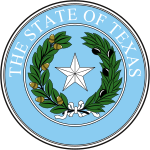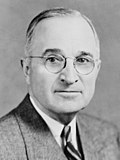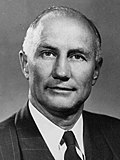| |||||||||||||||||||||||||||||||||
| |||||||||||||||||||||||||||||||||
 County Results
| |||||||||||||||||||||||||||||||||
| |||||||||||||||||||||||||||||||||
| Elections in Texas |
|---|
 |
|
|
The 1948 United States presidential election in Texas was held on November 2, 1948. Texas voters chose 23 electors to represent the state in the Electoral College, which chose the president and vice president.
As a former Confederate state, Texas had a history of Jim Crow laws, disenfranchisement of its African-American and Mexican-American populations, and single-party Democratic rule outside a few Unionist German-American counties (chiefly Gillespie and Kendall) of Central Texas. However, President Harry S. Truman was attempting to launch a civil rights bill, involving desegregation of the military, which led to severe opposition from Southern Democrats, who aimed to have South Carolina Governor Strom Thurmond listed as Democratic presidential nominee and Mississippi Governor Fielding Wright as the vice-presidential nominee. Thurmond, whose ticket was formally called the States’ Rights Democratic Party and more popularly known as the Dixiecrats, was leading Truman in early polls even in the major metropolitan counties of Dallas and Harris, which suggested he would claim the state.[1] Texas’ large number of electoral votes made it a coveted prize in Thurmond's quest to take the election into the House of Representatives.[2]
At the time of this poll it remained uncertain as to whether Truman or Thurmond would be the official Democratic nominee in Texas.[3] Unlike Oklahoma, Tennessee, North Carolina or Virginia, Texas did not have a major threat from the Republican Party to block local Democratic support for Thurmond,[4] but it had only a third the proportion of blacks found in Mississippi or South Carolina.[5] More critically, Texas’ party hierarchy was dominated by Truman loyalists,[6] most critically Governor Beauford Jester,[2] and by mid-September it was clear that Truman would be the official Democratic nominee.[6]
Truman campaigned in Texas during late September, ignoring civil rights and focusing entirely upon Dewey.[7] The President's criticism of Dewey was largely focused on improving the transmission of hydroelectric power from dams at lower rates than Dewey had planned.[7]
10% of white voters supported Thurmond.[8]
- ^ "Truman Bad 2d in Texas County Vote". Chicago Tribune. August 29, 1948. p. 1.
- ^ a b Frederickson, Kari. The Dixiecrat Revolt and the End of the Solid South, 1932-1968. p. 158. ISBN 0807875449.
- ^ "Texas Rebels Hail Victory over Truman: Thurmond Wins Nod in 3 Counties". Chicago Tribune. August 30, 1948. p. 3.
- ^ Key, Valdimer Orlando (1949). Southern Politics in State and Nation. Alfred A. Knopf. p. 336.
- ^ Key. Southern Politics, p. 254
- ^ a b Cohodas, Nadine. Strom Thurmond and the Politics of Southern Change. p. 182. ISBN 0865544468.
- ^ a b "Truman, in Texas, Ducks Civil Rights: President Ignores Challenge From Gov. Thurmond, Attacks GOP on Power Policy". Los Angeles Times. September 26, 1948. p. 8.
- ^ Black & Black 1992, p. 147.
© MMXXIII Rich X Search. We shall prevail. All rights reserved. Rich X Search



